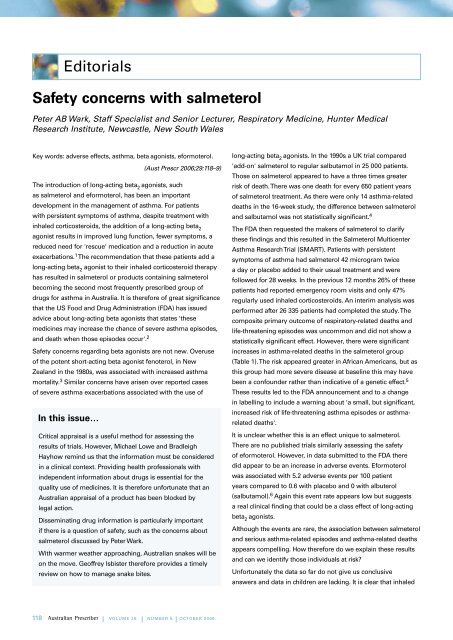download the full PDF issue - Australian Prescriber
download the full PDF issue - Australian Prescriber
download the full PDF issue - Australian Prescriber
Create successful ePaper yourself
Turn your PDF publications into a flip-book with our unique Google optimized e-Paper software.
Editorials<br />
Safety concerns with salmeterol<br />
Peter AB Wark, Staff Specialist and Senior Lecturer, Respiratory Medicine, Hunter Medical<br />
Research Institute, Newcastle, New South Wales<br />
Key words: adverse effects, asthma, beta agonists, eformoterol.<br />
In this <strong>issue</strong>…<br />
(Aust Prescr 2006;29:118–9)<br />
The introduction of long-acting beta2 agonists, such<br />
as salmeterol and eformoterol, has been an important<br />
development in <strong>the</strong> management of asthma. For patients<br />
with persistent symptoms of asthma, despite treatment with<br />
inhaled corticosteroids, <strong>the</strong> addition of a long-acting beta2 agonist results in improved lung function, fewer symptoms, a<br />
reduced need for 'rescue' medication and a reduction in acute<br />
exacerbations. 1 The recommendation that <strong>the</strong>se patients add a<br />
long-acting beta2 agonist to <strong>the</strong>ir inhaled corticosteroid <strong>the</strong>rapy<br />
has resulted in salmeterol or products containing salmeterol<br />
becoming <strong>the</strong> second most frequently prescribed group of<br />
drugs for asthma in Australia. It is <strong>the</strong>refore of great significance<br />
that <strong>the</strong> US Food and Drug Administration (FDA) has <strong>issue</strong>d<br />
advice about long-acting beta agonists that states '<strong>the</strong>se<br />
medicines may increase <strong>the</strong> chance of severe asthma episodes,<br />
and death when those episodes occur'. 2<br />
Safety concerns regarding beta agonists are not new. Overuse<br />
of <strong>the</strong> potent short-acting beta agonist fenoterol, in New<br />
Zealand in <strong>the</strong> 1980s, was associated with increased asthma<br />
mortality. 3 Similar concerns have arisen over reported cases<br />
of severe asthma exacerbations associated with <strong>the</strong> use of<br />
Critical appraisal is a useful method for assessing <strong>the</strong><br />
results of trials. However, Michael Lowe and Bradleigh<br />
Hayhow remind us that <strong>the</strong> information must be considered<br />
in a clinical context. Providing health professionals with<br />
independent information about drugs is essential for <strong>the</strong><br />
quality use of medicines. It is <strong>the</strong>refore unfortunate that an<br />
<strong>Australian</strong> appraisal of a product has been blocked by<br />
legal action.<br />
Disseminating drug information is particularly important<br />
if <strong>the</strong>re is a question of safety, such as <strong>the</strong> concerns about<br />
salmeterol discussed by Peter Wark.<br />
With warmer wea<strong>the</strong>r approaching, <strong>Australian</strong> snakes will be<br />
on <strong>the</strong> move. Geoffrey Isbister <strong>the</strong>refore provides a timely<br />
review on how to manage snake bites.<br />
118 | VOLUME 29 | NUMBER 5 | OCTOBER 2006<br />
long-acting beta2 agonists. In <strong>the</strong> 1990s a UK trial compared<br />
'add-on' salmeterol to regular salbutamol in 25 000 patients.<br />
Those on salmeterol appeared to have a three times greater<br />
risk of death. There was one death for every 650 patient years<br />
of salmeterol treatment. As <strong>the</strong>re were only 14 asthma-related<br />
deaths in <strong>the</strong> 16-week study, <strong>the</strong> difference between salmeterol<br />
and salbutamol was not statistically significant. 4<br />
The FDA <strong>the</strong>n requested <strong>the</strong> makers of salmeterol to clarify<br />
<strong>the</strong>se findings and this resulted in <strong>the</strong> Salmeterol Multicenter<br />
Asthma Research Trial (SMART). Patients with persistent<br />
symptoms of asthma had salmeterol 42 microgram twice<br />
a day or placebo added to <strong>the</strong>ir usual treatment and were<br />
followed for 28 weeks. In <strong>the</strong> previous 12 months 26% of <strong>the</strong>se<br />
patients had reported emergency room visits and only 47%<br />
regularly used inhaled corticosteroids. An interim analysis was<br />
performed after 26 335 patients had completed <strong>the</strong> study. The<br />
composite primary outcome of respiratory-related deaths and<br />
life-threatening episodes was uncommon and did not show a<br />
statistically significant effect. However, <strong>the</strong>re were significant<br />
increases in asthma-related deaths in <strong>the</strong> salmeterol group<br />
(Table 1). The risk appeared greater in African Americans, but as<br />
this group had more severe disease at baseline this may have<br />
been a confounder ra<strong>the</strong>r than indicative of a genetic effect. 5<br />
These results led to <strong>the</strong> FDA announcement and to a change<br />
in labelling to include a warning about 'a small, but significant,<br />
increased risk of life-threatening asthma episodes or asthmarelated<br />
deaths'.<br />
It is unclear whe<strong>the</strong>r this is an effect unique to salmeterol.<br />
There are no published trials similarly assessing <strong>the</strong> safety<br />
of eformoterol. However, in data submitted to <strong>the</strong> FDA <strong>the</strong>re<br />
did appear to be an increase in adverse events. Eformoterol<br />
was associated with 5.2 adverse events per 100 patient<br />
years compared to 0.6 with placebo and 0 with albuterol<br />
(salbutamol). 6 Again this event rate appears low but suggests<br />
a real clinical finding that could be a class effect of long-acting<br />
beta2 agonists.<br />
Although <strong>the</strong> events are rare, <strong>the</strong> association between salmeterol<br />
and serious asthma-related episodes and asthma-related deaths<br />
appears compelling. How <strong>the</strong>refore do we explain <strong>the</strong>se results<br />
and can we identify those individuals at risk?<br />
Unfortunately <strong>the</strong> data so far do not give us conclusive<br />
answers and data in children are lacking. It is clear that inhaled

















